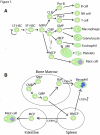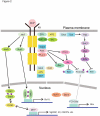Development, migration, and survival of mast cells
- PMID: 16760571
- PMCID: PMC1490026
- DOI: 10.1385/IR:34:2:97
Development, migration, and survival of mast cells
Abstract
Mast cells play a pivotal role in immediate hypersensitivity and chronic allergic reactions that can contribute to asthma, atopic dermatitis, and other allergic diseases. Because mast cell numbers are increased at sites of inflammation in allergic diseases, pharmacologic intervention into the proliferation, migration, and survival (or apoptosis) of mast cells could be a promising strategy for the management of allergic diseases. Mast cells differentiate from multipotent hematopoietic progenitors in the bone marrow. Stem cell factor (SCF) is a major chemotactic factor for mast cells and their progenitors. SCF also elicits cell-cell and cell-substratum adhesion, facilitates the proliferation, and sustains the survival, differentiation, and maturation, of mast cells. Therefore, many aspects of mast cell biology can be understood as interactions of mast cells and their precursors with SCF and factors that modulate their responses to SCF and its signaling pathways. Numerous factors known to have such a capacity include cytokines that are secreted from activated T cells and other immune cells including mast cells themselves. Recent studies also demonstrated that monomeric IgE binding to FcepsilonRI can enhance mast-cell survival. In this review we discuss the factors that regulate mast cell development, migration, and survival.
Figures


Similar articles
-
The development of human mast cells. An historical reappraisal.Exp Cell Res. 2016 Mar 15;342(2):210-5. doi: 10.1016/j.yexcr.2016.03.013. Epub 2016 Mar 17. Exp Cell Res. 2016. PMID: 26997528 Review.
-
The role of human mast cell-derived cytokines in eosinophil biology.J Interferon Cytokine Res. 2004 May;24(5):271-81. doi: 10.1089/107999004323065057. J Interferon Cytokine Res. 2004. PMID: 15153310 Review.
-
Mast Cell Biology at Molecular Level: a Comprehensive Review.Clin Rev Allergy Immunol. 2020 Jun;58(3):342-365. doi: 10.1007/s12016-019-08769-2. Clin Rev Allergy Immunol. 2020. PMID: 31828527 Review.
-
Mast cell research.Chem Immunol Allergy. 2014;100:165-71. doi: 10.1159/000358733. Epub 2014 May 22. Chem Immunol Allergy. 2014. PMID: 24925397
-
Targeting mast cells in inflammatory diseases.Pharmacol Ther. 2014 Jun;142(3):416-35. doi: 10.1016/j.pharmthera.2014.01.004. Epub 2014 Jan 31. Pharmacol Ther. 2014. PMID: 24486828 Review.
Cited by
-
Mast cell function is not altered by Coronin-1A deficiency.J Leukoc Biol. 2010 Oct;88(4):737-45. doi: 10.1189/jlb.0310131. Epub 2010 Jul 19. J Leukoc Biol. 2010. PMID: 20643816 Free PMC article.
-
Mechanical Skin Injury Promotes Food Anaphylaxis by Driving Intestinal Mast Cell Expansion.Immunity. 2019 May 21;50(5):1262-1275.e4. doi: 10.1016/j.immuni.2019.03.023. Epub 2019 Apr 23. Immunity. 2019. PMID: 31027995 Free PMC article.
-
Mast Cells as Important Regulators in Autoimmunity and Cancer Development.Front Cell Dev Biol. 2021 Oct 12;9:752350. doi: 10.3389/fcell.2021.752350. eCollection 2021. Front Cell Dev Biol. 2021. PMID: 34712668 Free PMC article. Review.
-
Single-Cell Transcriptomics of a Human Kidney Allograft Biopsy Specimen Defines a Diverse Inflammatory Response.J Am Soc Nephrol. 2018 Aug;29(8):2069-2080. doi: 10.1681/ASN.2018020125. Epub 2018 Jul 6. J Am Soc Nephrol. 2018. PMID: 29980650 Free PMC article. Review.
-
Molecular regulation of mast cell development and maturation.Mol Biol Rep. 2010 Apr;37(4):1993-2001. doi: 10.1007/s11033-009-9650-z. Epub 2009 Jul 31. Mol Biol Rep. 2010. PMID: 19644767 Review.
References
-
- Metcalfe DD, Baram D, Mekori YA. Mast cells. Physiol Rev. 1997;77(4):1033–79. - PubMed
-
- Galli SJ, Maurer M, Lantz CS. Mast cells as sentinels of innate immunity. Curr Opin Immunol. 1999;11(1):53–9. - PubMed
-
- Lee DM, Friend DS, Gurish MF, Benoist C, Mathis D, Brenner MB. Mast cells: a cellular link between autoantibodies and inflammatory arthritis. Science. 2002;297(5587):1689–92. - PubMed
Publication types
MeSH terms
Substances
Grants and funding
LinkOut - more resources
Full Text Sources
Other Literature Sources

